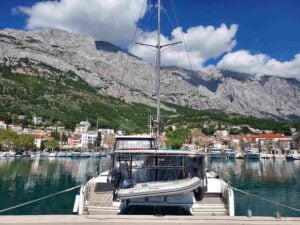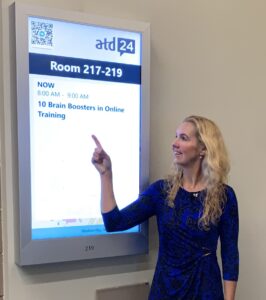Now it was time to visit the last province in Italy, the beautiful Puglia.

First, we prepared ourselves for a sail in South of Italy, from Cariati which is in the province of Calabria, to the ‘heel’ of the Italian booth, to Puglia. This ‘crossing’ was 58 miles, which would take about 12 hours sailing. So we left at 6.30h at sunrise in Cariati and arrived at 17.00h in Gallipoli, just before sunset:
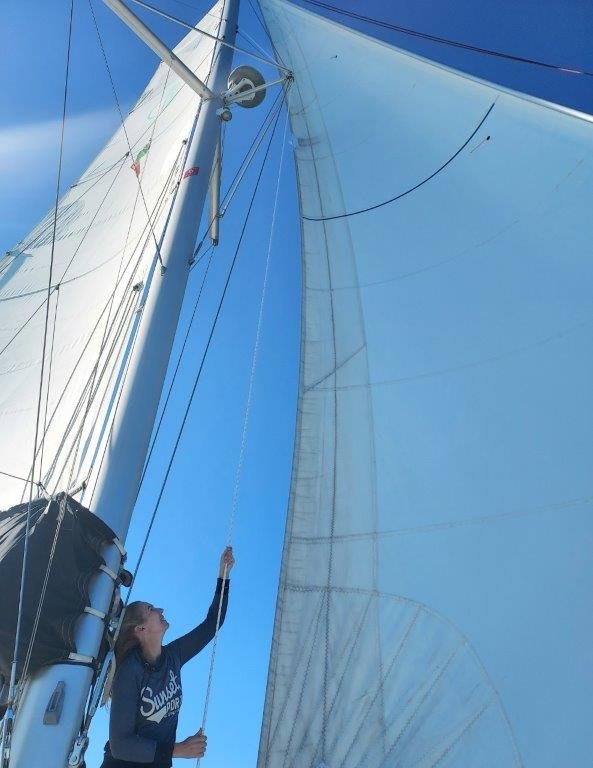
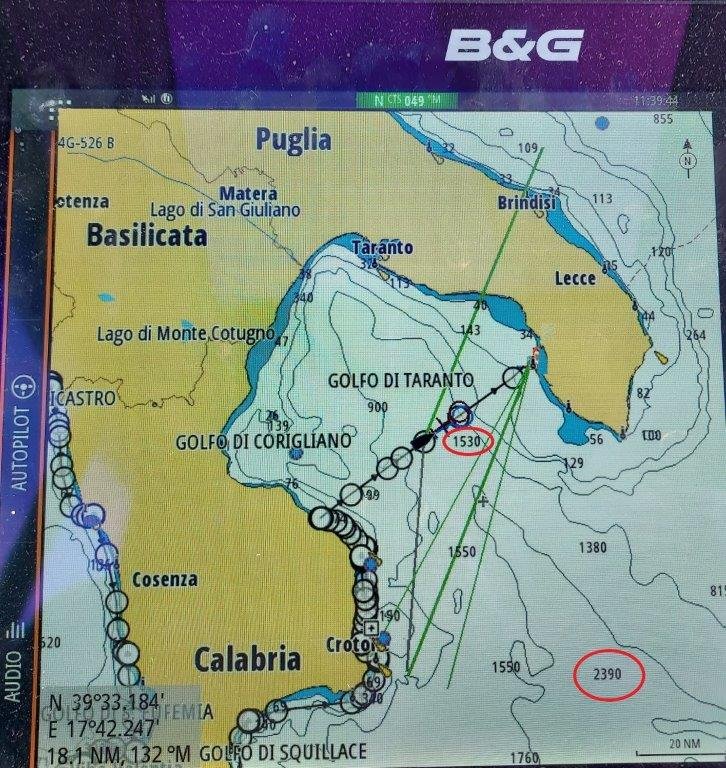
As you can see from our navigation screen, B&G, in these waters, called ‘Golfo di Taranto’, we crossed depths of 1.530 meters and even a bit south of Italy, it’s over 2.300 meters. The variety in depths at the bottom of the Mediterranean Sea keeps surprising me!
Gallipoli
Gallipoli turned out to be a charming place. The ancient Greeks already knew it when they came up with the name for this town: they called this port town kalé pólis, beautiful town. The Italians corrupted the name to Gallipoli. And 12 hours of sailing makes hungry, so we ordered 1 meter of pizza, in 3 different flavors, so 4 pieces of 1 flavor, a great concept we thought 😉. The waitress thought it was too much and we explained that it probably was the case, but that in Holland there is a saying ‘that our eyes often are bigger than our stomach’, and she laughed out loud!


When we cycled through the city the next day, we loved the maze of narrow streets and white plastered walls. Here you see me in front of 1 of the many small harbors and also the Castello di Gallipoli. Also, the fountain of Gallipoli, build by the Greeks is impressive to see.
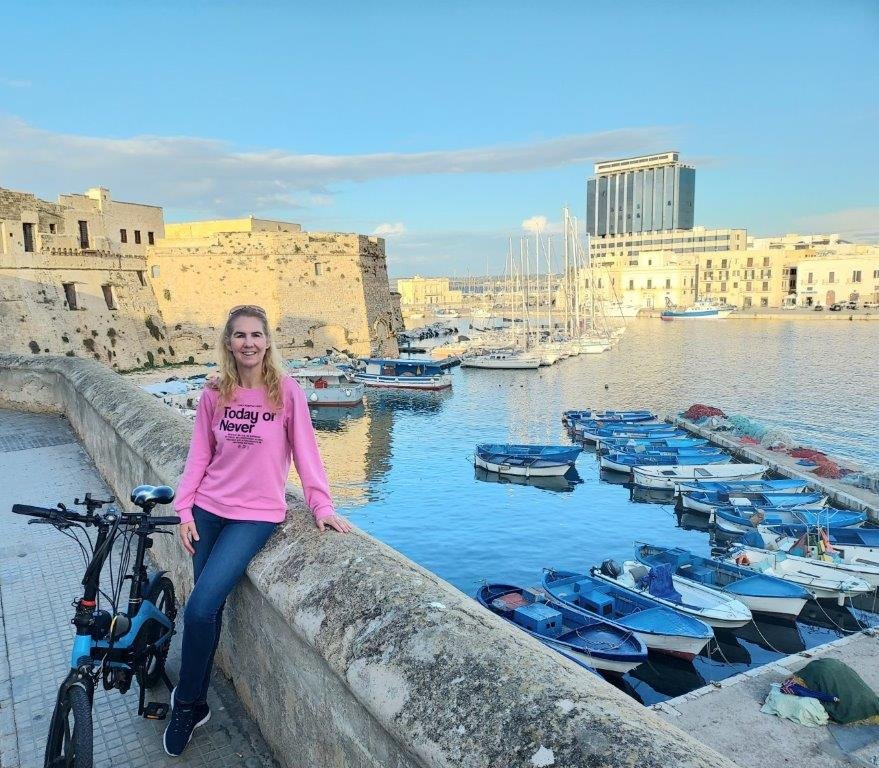

And there is also modern culture, because a sophisticated gay scene has developed around Gallipoli, often referred to as “Gay-lipoli”. The city is particularly well known as a destination for the Italian gay population and has become “Italy’s gay summer paradise” because of the many beaches and parties.
Santa Maria di Leuca
There were not many harbors at the coastline of Puglia to our surprise, to the next harbor was about 6 hours of sailing away. And it was the most southern tip of Italy, Santa Maria di Leuca. At that sea side resort, the Ionian and Adriatic Seas flow into each other. The ‘border function’ of the cape in Santa Maria di Leuca is also called ‘finis terrae’ – the end of the world. It is not only the symbolic end, but also quite literally the end of the territory of the Italian mainland. There was much to see, so we stayed for 2 days.
First, this town is known for its iconic 47 meter high lighthouse that rises up to 102 meters above sea level. We cycled from the harbor below to the rock with the lighthouse. It is said that on a clear day the view from there reaches as far as Greece and sometimes even as far as Albania. So we took our e-step and e-bike and binoculars with us started cycling from the harbor uphill.

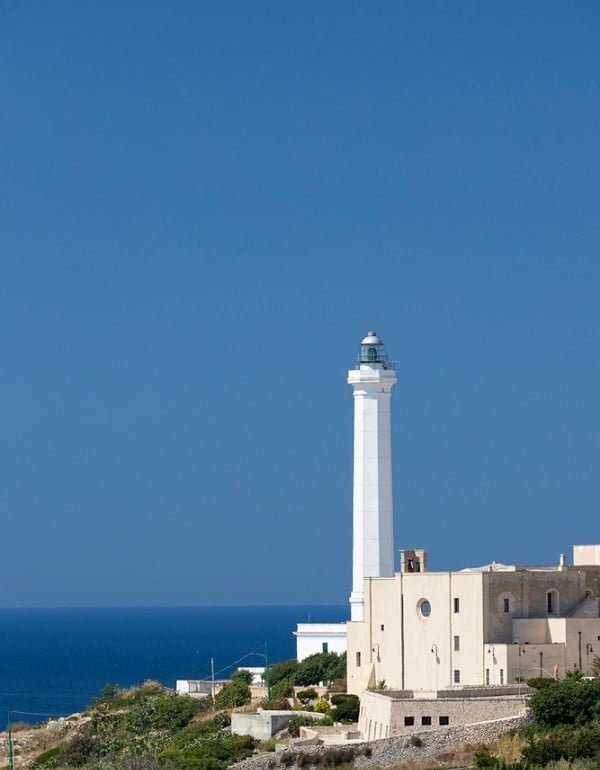
We always had the lighthouse in our sights and when we were at the top of the hill and parked our bikes, we started staring at the other side of Italy and actually saw outlines of land.
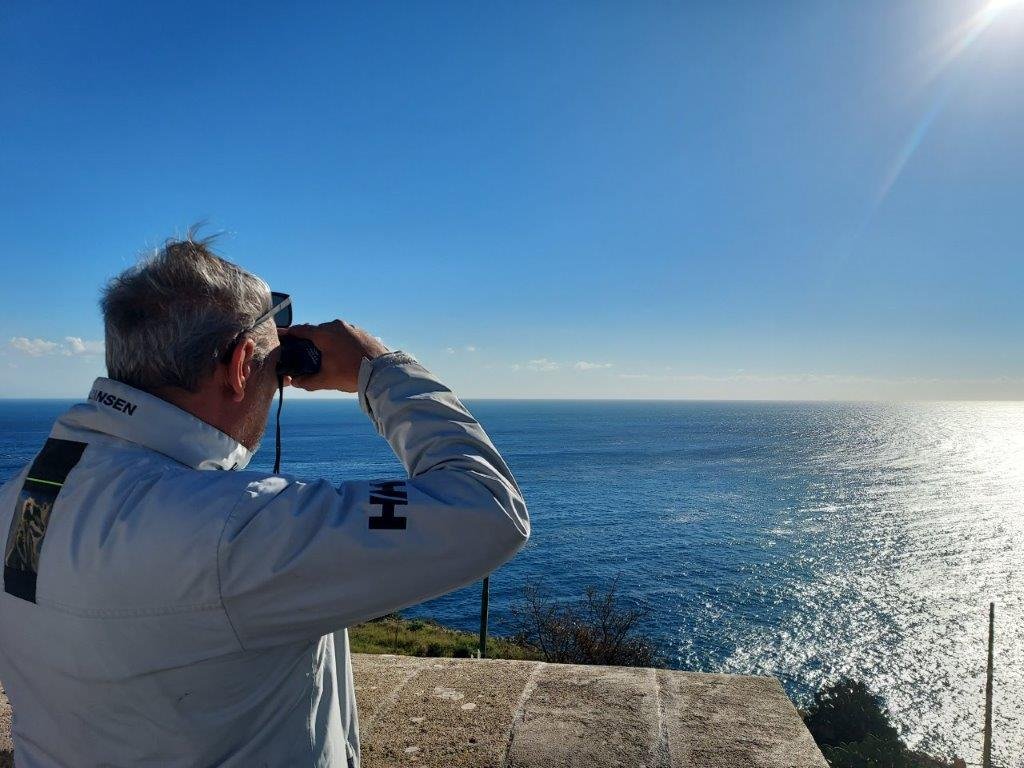
When we walked to the other side of the view point, we could see the harbor and our catamaran (see red arrow).
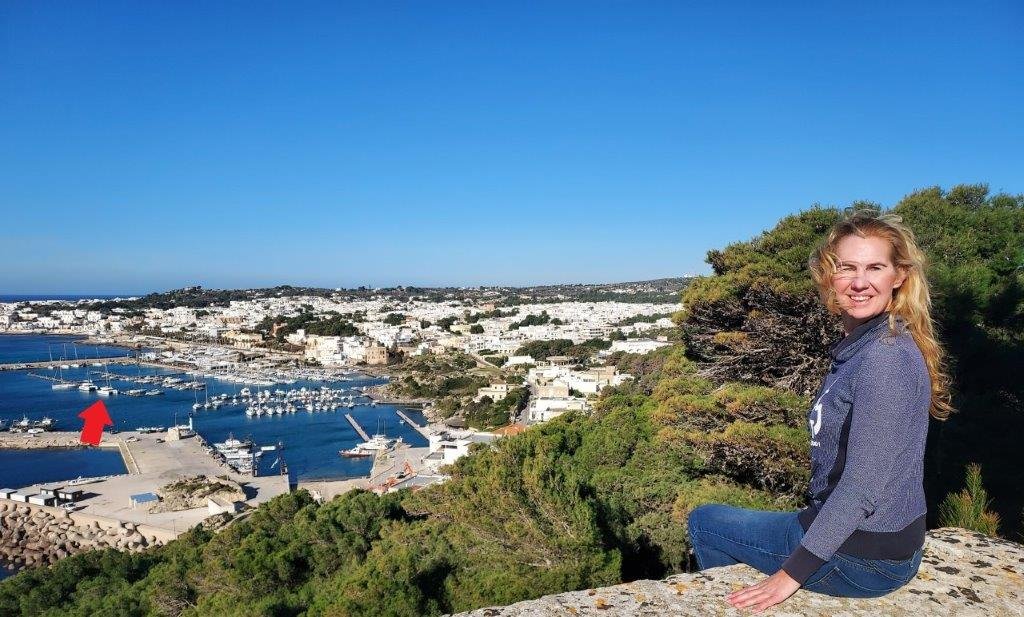
Behind the lighthouse is a large square, with the Basilica di Santa Maria de Finibus Terrae. An important place for the Catholic Church, this basilica is, according to legend, the threshold to the porch of paradise, because it is precisely here that Peter himself first set foot on Italian shores to preach the Gospel to the inhabitants.
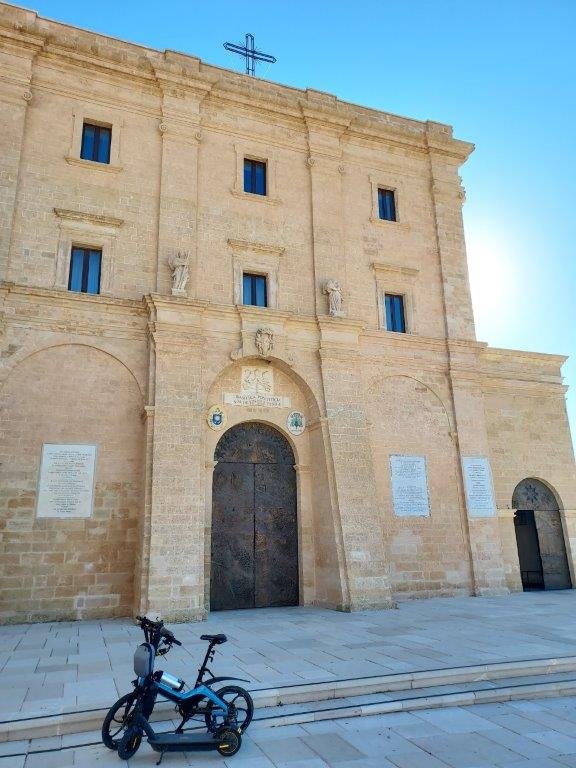
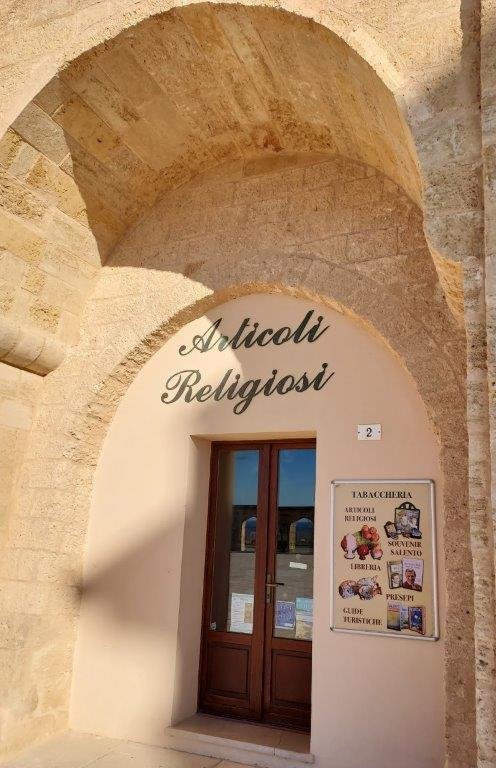
And what I, as a Protestant, find typically Roman Catholic is the commercial shop next to the church which had advertised above the door ‘Articoli Religiosi’, in other words, buy your religious souvenirs here!
There is a statue of Mary in the church, which is placed close to the altar.


Every year, on August 14, the statue of Mary is carried from the basilica to spend a night in a different church. The next day, Maria is carried to the harbor and sailed by boat to the port of San Gregorio – and back. In the church we saw photos of this procession. Only when Maria is safely back in Santa Maria di Leuca is it time for fireworks and celebration.
We left the square with many interesting things to see, and cycled back to the town of Santa Maria di Leuca.

At the foot of the church you can admire particularly beautiful Art Nouveau villas.
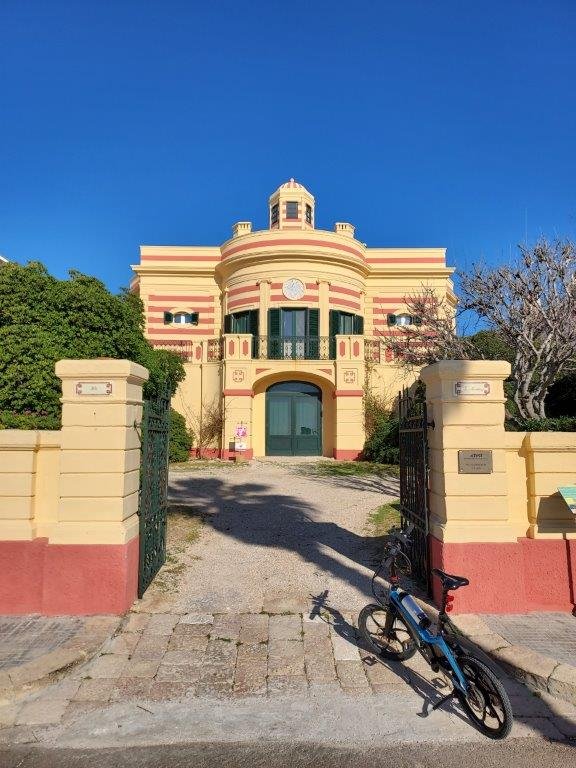
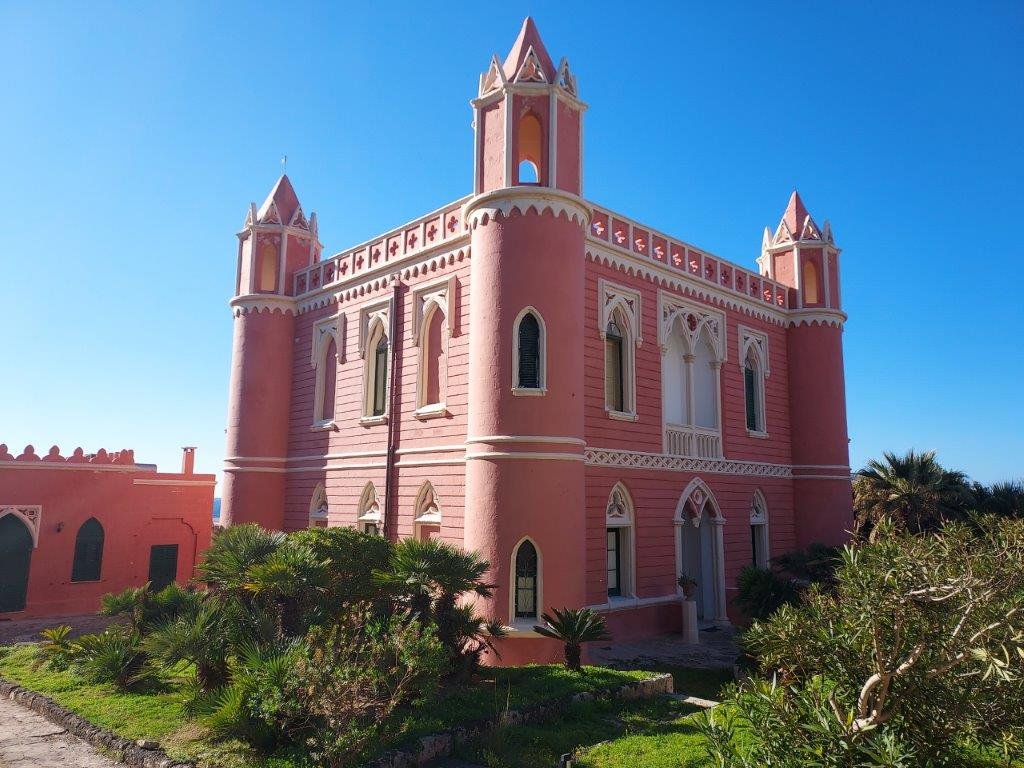
Sometimes you’ll find the most beautiful spots by not following directions, but just walking around, go away from the beaten track and find these lovely beach houses at amazing water.

What is different at this coastline compared to the Calabrian coastline, is that there are many caves. You can approach them from sea with a dingy and sometimes can swim in the caves. And the cave we visited can also be approached from land, the Grotta del Drago (Dragon Cave). When we cycled there, we only saw a small hole in the ground and as we descended further and further, we discovered a big space which was the cave.
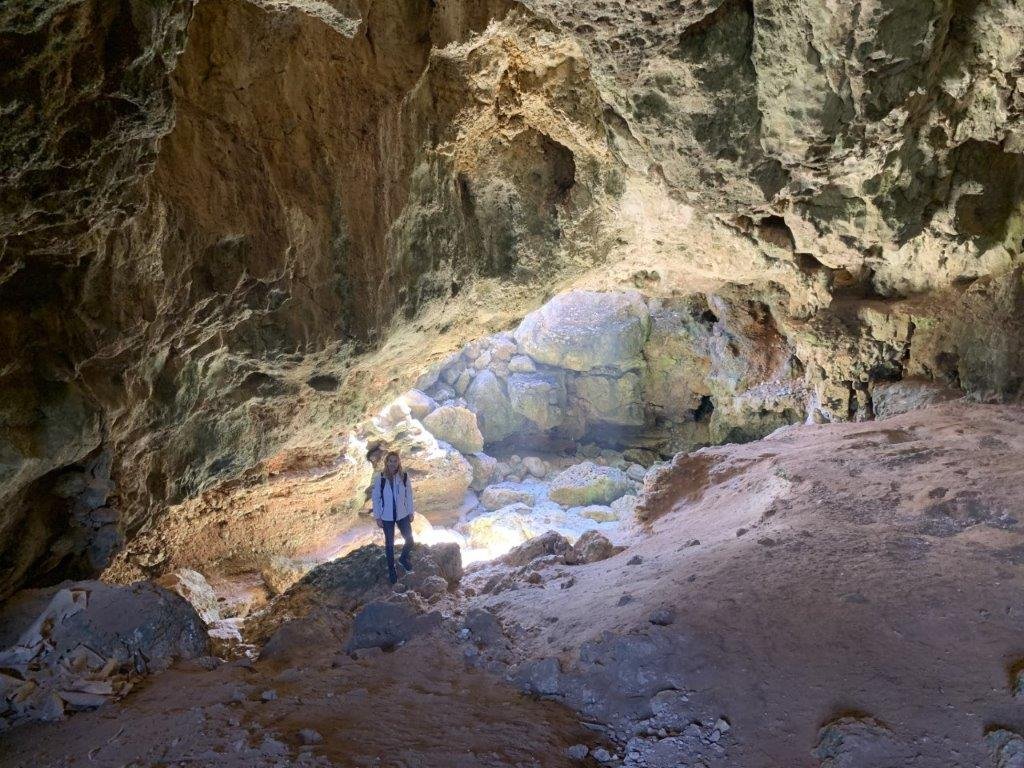
Climbing out the cave again, and sitting on the grass field above it, looking out over the sea towards the light house, you would never guess there was this huge cave beneath!

Next morning we left his beautiful place and as we rounded the cape, we had a nice view on the lighthouse.
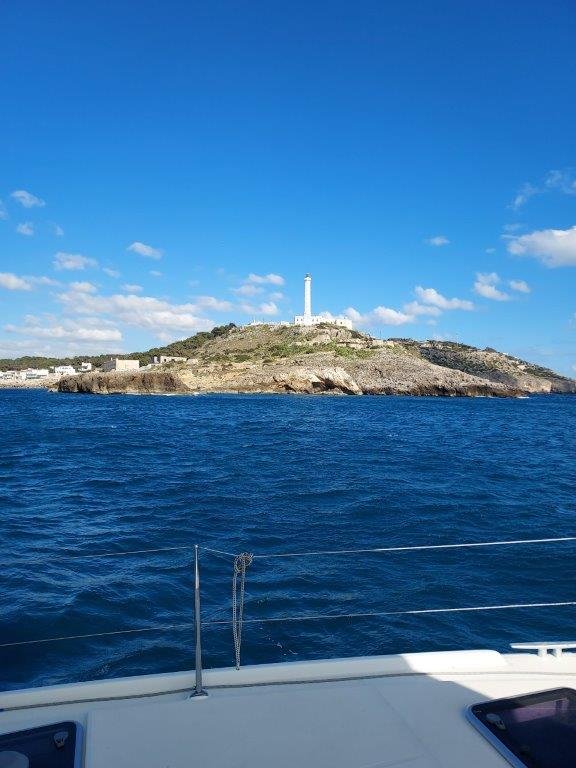
Castro
The wind was getting stronger and was north, so we had to fight against waves and current. We decided to change our plan for a harbor and find shelter halfway at a small harbor called Marina Castro. It was full of fishing boats and now 1 catamaran. I called the harbormaster and he completely understood, having lived here his whole life and knowing about the hard winds in this area. He told us, no worries, come to our harbor, we have no electricity or water, but you can stay for free at the sheltered quay for 1 night. Very kind! We didn’t expect these great rock walls that surrounded us in this small marina.
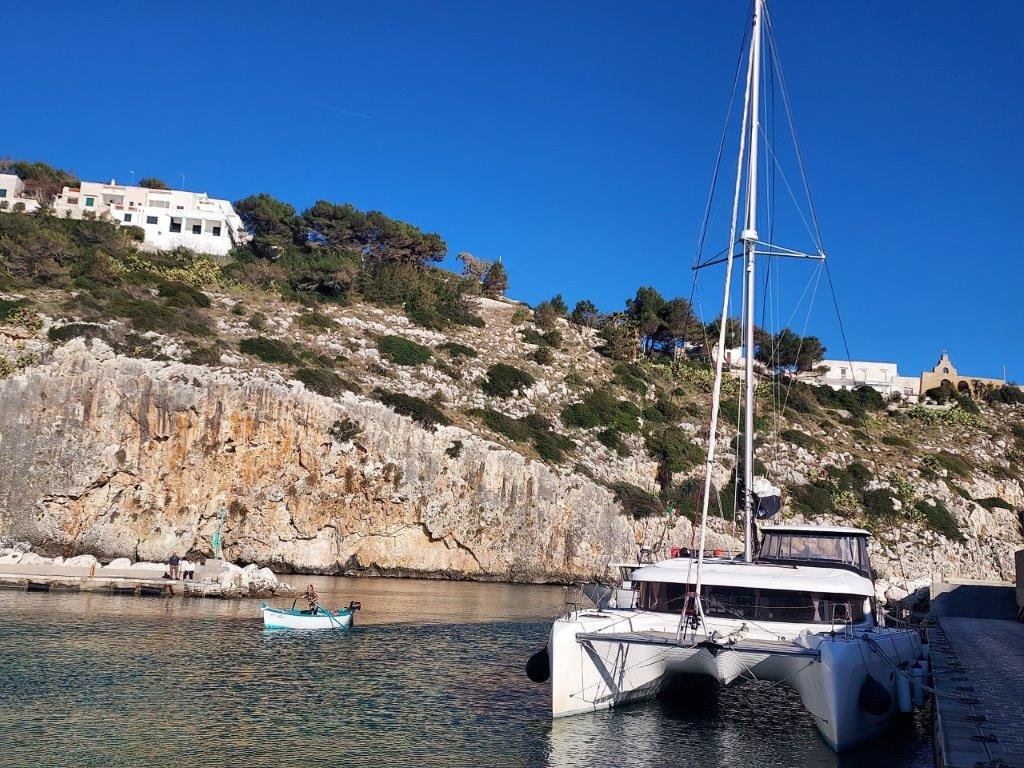
Dolphins ahead!
We came closer to Brindisi, and more and more into the Adriatic sea. I remembered looking at the depths, which changed from 30 meters to 90 meters and the sea temperature which had been around 15 and 16 degrees Celsius in February of all of a sudden 17 degrees. And then we saw them: dolphins!
The black fins were about 50 meters in front of our boat, feeding themselves with fish and 5 seconds later, you see 4 dolphins swimming and jumping in front of your boat, amazing!
Only for a few minutes they are there, swim with you, zigzagging, diving down, jumping above the water again and then they’re gone.
Apparently this spot had great conditions (temperature, depth, food, seas coming together) for them.
They were the first dolphins we had seen in the Med since Corsica beginning of October 2023. And this was so early in the season, I wasn’t expecting to see dolphins till May!
Brindisi
I didn’t know about Brindisi, but the town was very charming. For instance the Piazza Duomo where the sunset gives a golden yellow glow to the cathedral.
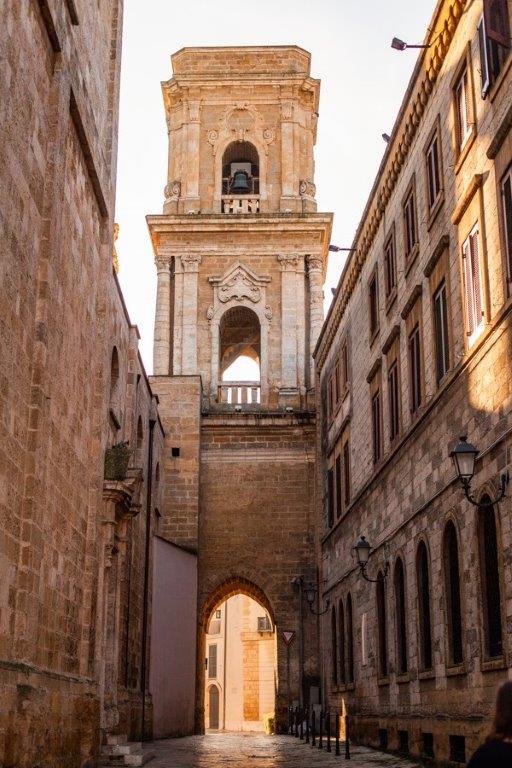

What I didn’t know was that from this place a lot of crusaders left in boats to the Holy Land around the year 1300, called by the Pope to defend and rescue Jerusalem. In the church there was even a wooden horse and rider, representing that period.
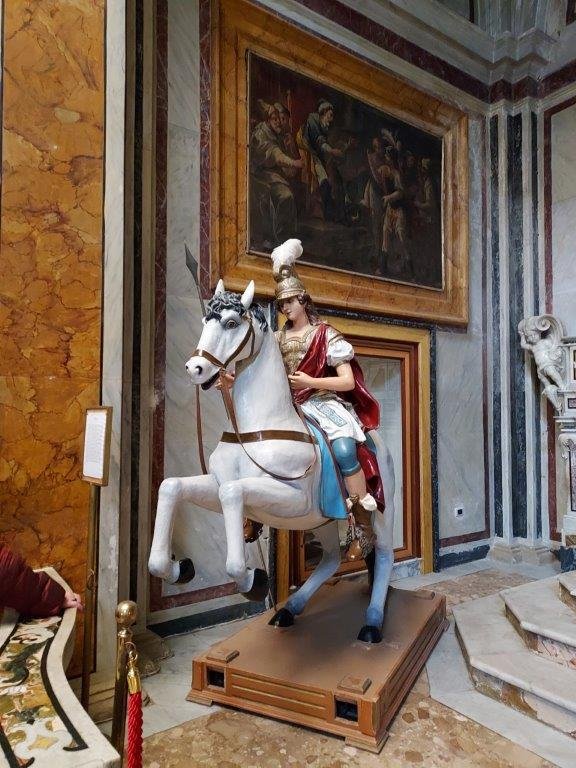
Many of these crusaders came from all over Europe, first to Rome and from there walking or driving along the most famous road in all of Italy: the Via Appia. Not only crusaders, but during ancient times also traders and travelers took this road to travel south of the boot, to Brindisi, where the terminus of the Via Appia is marked by an ancient Roman column, which still remains after all this time. stands tall.

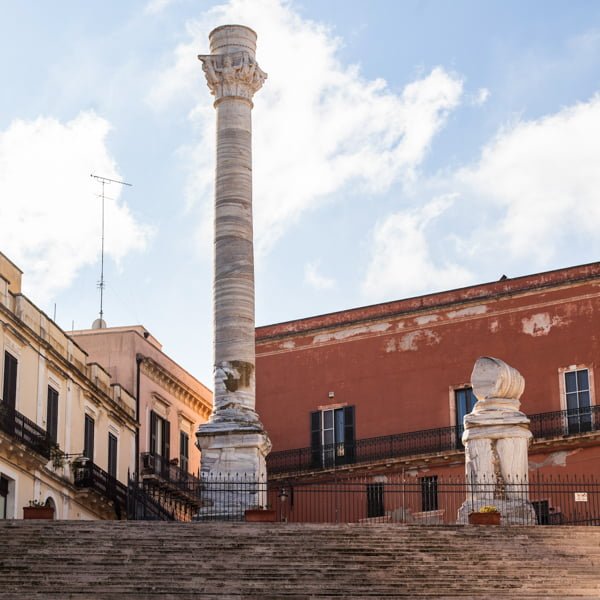
Brindisi is part of the region of Lecce, famous for world war 2 period where Benito Mussolini ruled.

Also I noticed a lot of deer heads and antlers on the walls of the city, it turned out that this was the symbol of the city. Brunda, was the name given to Brindisi by the Messapians, ‘deer’s head’. This name is more than aptly chosen, because the port of Brindisi is indeed shaped like a deer’s antlers. That is why you see the deer head everywhere, including in the city coat of arms of Brindisi.


The harbor was very quiet, it’s not the season where people sail (but we love winter sailing because of this!) and we were about the only people on our boat in the harbor. And knock, knock, who is there: Guardia Costiera. After 7 months of sailing Italy and almost ready to leave for Croatia, never been checked before during all that time in Italy, now they want to check us out 😉. They came aboard and the atmosphere was friendly from the start, checking our boat papers, insurance, ownership of the boat, company paper, payment of the tax of the boat, passport. About 30 minutes later, they left again.

Monopoli
Of course we had to go to this next place on the coast of Puglia: Monopoli! And of course they had the famous game in one of the shops displayed:
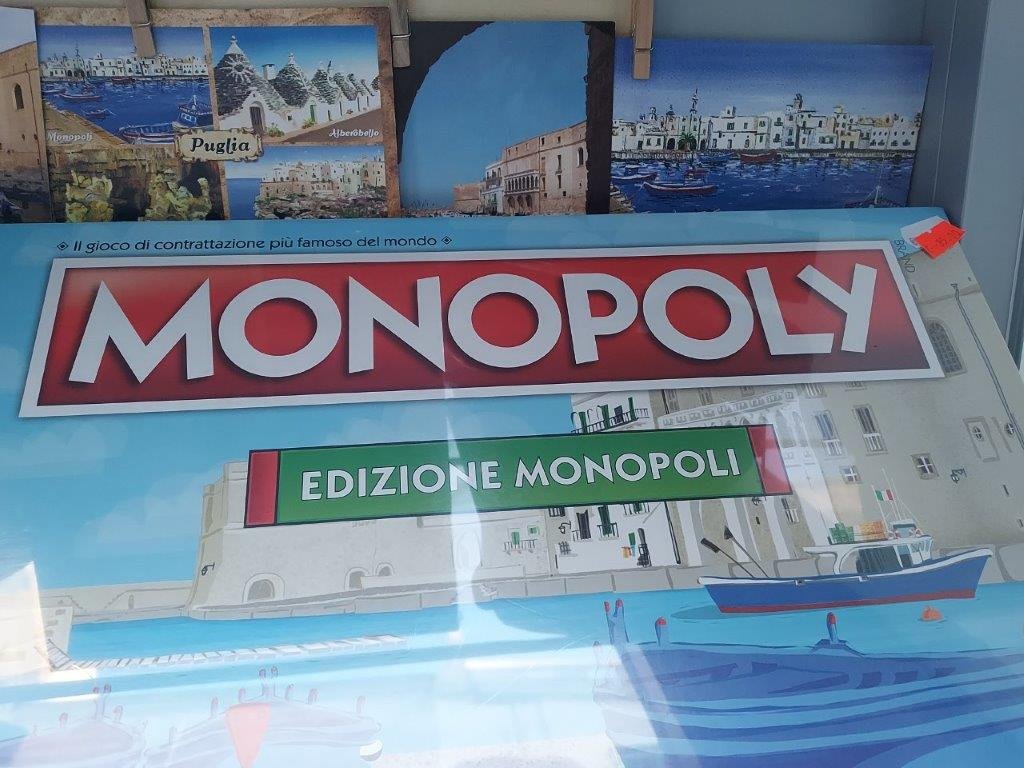
The city was great to see and also gave a bit of a Greek vibe, lots of blue and white in the city.


It was fun walking around here, also thankful for the sunny weather end of February.
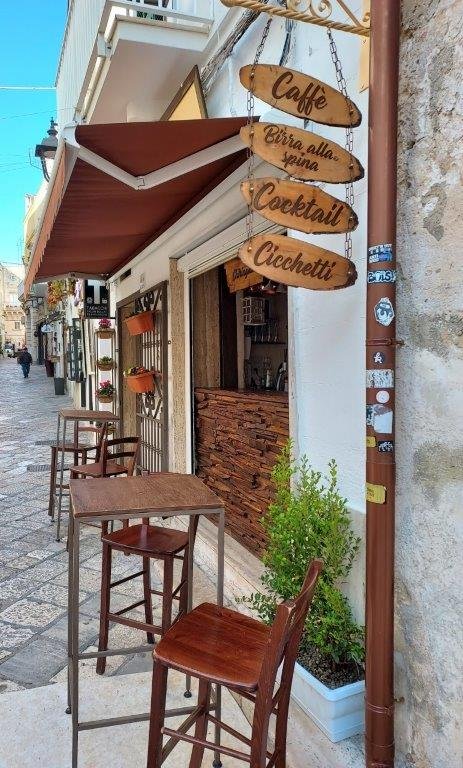
There are many churches in Monopoli and 1 church is very surprising, also because it is not as lovely as the rest of the town.
Officially this church is called Santa Maria del Suffragio, but the locals call it the Chiesa del Purgatorio, the ‘Church of Purgatory’. It is not surprising when you see that skulls and skeletons decorate this building.
On the entrance door there are already two depicted skeletons opposite of each other, both surrounded by symbols. You see a crown and a miter, but also various working tools. There is a special message behind this: whether you are rich or poor, everyone is equal after death.


While other churches mainly honor important clergymen, here it is ‘the ordinary person’. And in a somewhat grisly way: there are eight mummified bodies on display, dressed in black robes, through a window we could view these mummies.
Quickly back to the lovely part of this town, namely the view of our boat that was lying in the sun, tied to the quay with a view of Monopoli.


Alberobello
We rented a car to see the biggest attraction in Puglia: the trulli. A trullo is a white house with a cone-shaped roof. They were built in rural areas for poor people and were relatively cheap to build without cement. It did not get humid as quickly inside and the rooms remained relatively cool in the summer and warm in the winter.


The cone-shaped roofs are sometimes decorated with symbolic, religious or downright mysterious symbols – said to keep evil away.

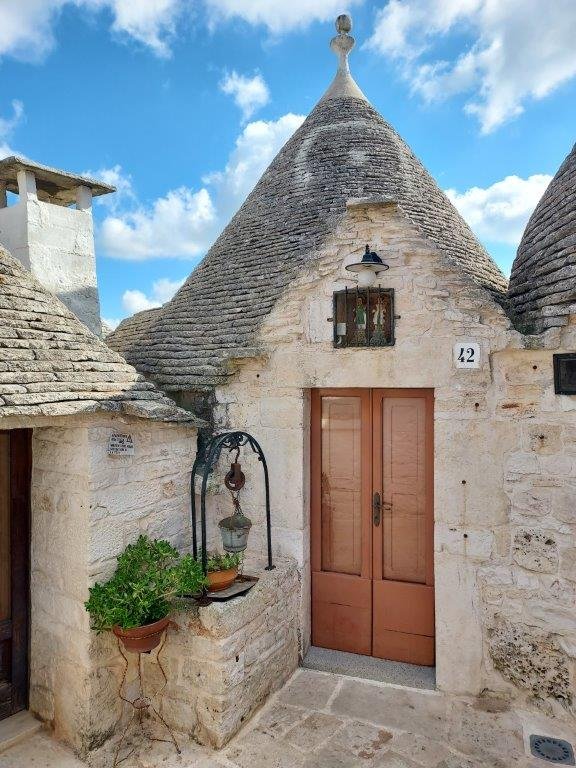
The ‘capital’ of the trulli is Alberobello, where the old center consists of winding streets lined with more than a thousand traditional round white houses. We found it enchanting to see, especially from this panoramic platform, where you had a great view over the neighborhoods with all the trulli.
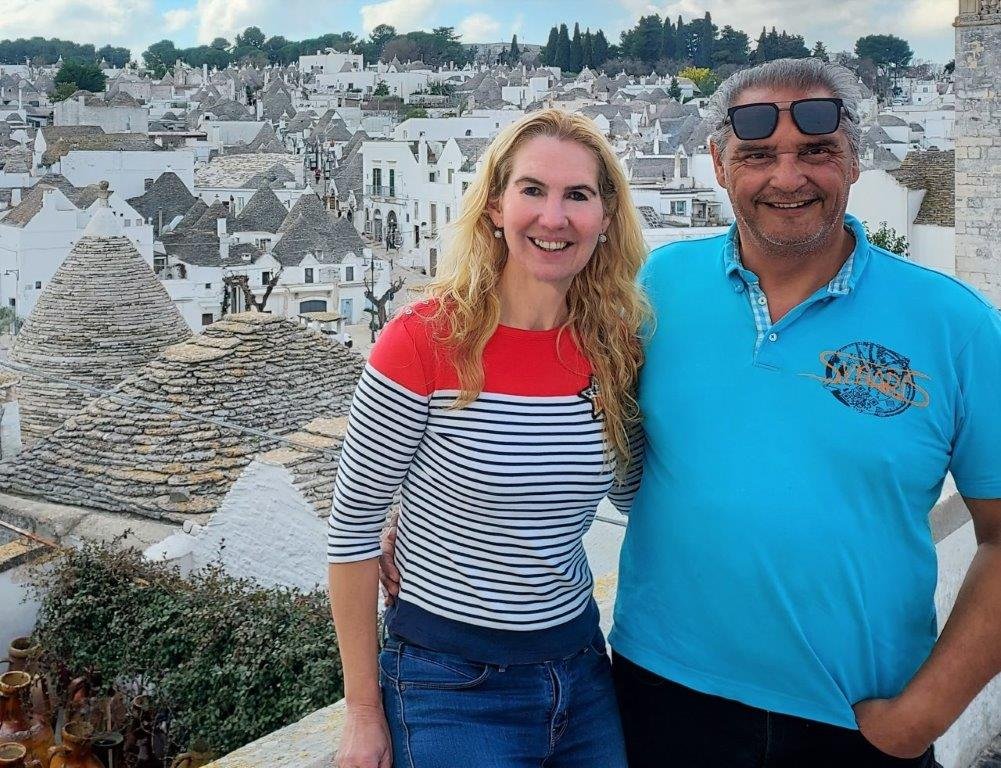
We flew our drone over the streets with trulli.
It is now the low season, so you could walk through the streets, there was enough space to view the houses and also talk to some people who lived there or had set up a shop. I also had my online sessions on the boat that week and thought it was a nice opportunity to take ‘work photos’ at the trulli!


Matera
Since we had a car, I was also curious to see the ancient town Matera. It’s a special city.
Matera is famous for the so-called Sassi, cave houses. The story goes that the rocks on the spot where Matera is now served as shelters for monastics who had fled from the Byzantine Empire since the eighth century. Gradually they carved out more and more ‘dwellings’ in the caves.
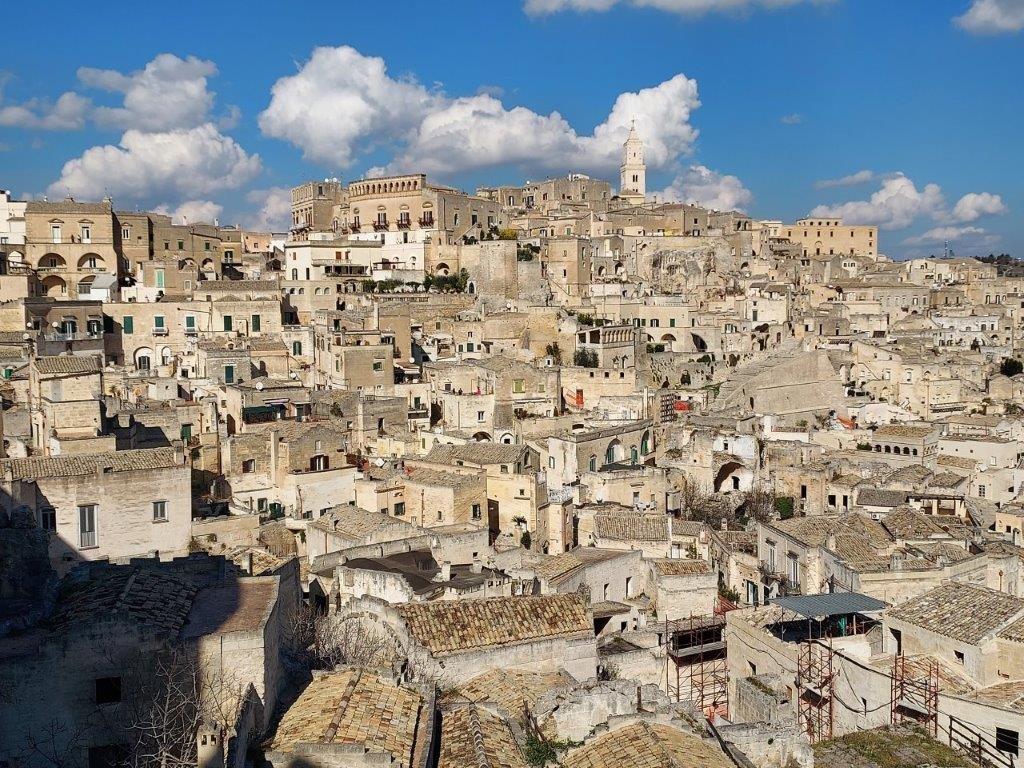

Even as late as 1950, some thirty to forty thousand people still lived in the cave houses that are so characteristic of Matera. However, due to poor sanitary conditions (people often lived together with animals in the same room), the mortality rate was very high. Due to these dangerous living conditions, the decision was therefore made that everyone had to leave the Sassi.


We walked through the streets and were amazed at their antiquity. The drone shows how uniquely this city is built, with a canyon on one side and a hill on the other.
The beautiful place has not escaped the attention of the film world as the James Bond film ‘No time do die’ was filmed here in 2020. In this 2-minute film you see ‘behind the scenes’ images that we also saw when we walked around in Matera. The motorbike jump at 1.33 minutes in this video was especially spectacular.
The square where the motorbike lands now houses a bar with a new cocktail on the menu, called ‘007 jump’ 😉

Bari
Last stop in Italy would be the city of Bari. Bari is the capital of Puglia, and after Naples, Bari is the largest city in southern Italy, but the old center is very compact and therefore easy to explore on foot.

In the oldest part of Bari, the ‘Via delle Orecchiette’ is a must-see. This street owes its name to the women who quickly make the most delicious orecchiette (ear-shaped pasta) in the morning. Their skilled hands transform the pasta dough into little ears. Later in the day, the fresh pasta is left to dry in a kind of large shuffleboard table next to the houses. You can buy a portion of pasta so that you can taste the results of that lightning-fast and age-old manual labor later in the day.
I thought this was the nicest part of Bari and I walked through the street again, but this time with my mobile phone on film mode ;).
Of course, the castle of Bari was also beautiful to see and the nice little streets, where you can secretly look into courtyards.


Our harbor was on the edge of the city, we floated quietly and sheltered next to other boats.

Many ferries depart from Bari to Greece, Albania and Croatia.


We wanted to cross to Croatia and when we saw the stable and beautiful weather for the coming days, we took the plunge: ‘Shall we sail to Dubrovnik tomorrow on Saterday? It’s 21 hours sailing, we will be arriving on Sundaymorning, should I reserve a port in advance?’ No sooner said than done. After sailing in wonderful Italy for 7 months, it is time for a new adventure: Croatia!

